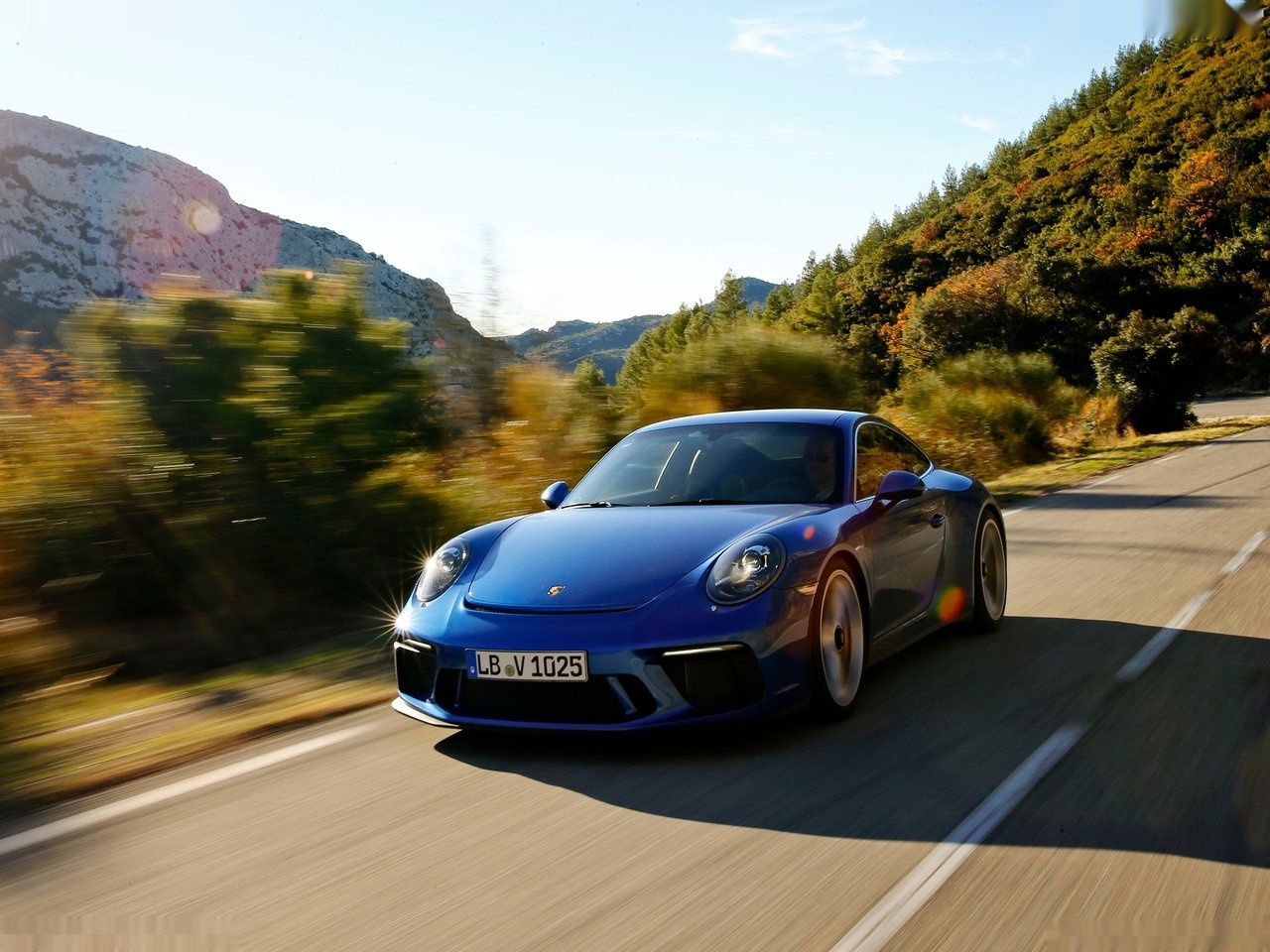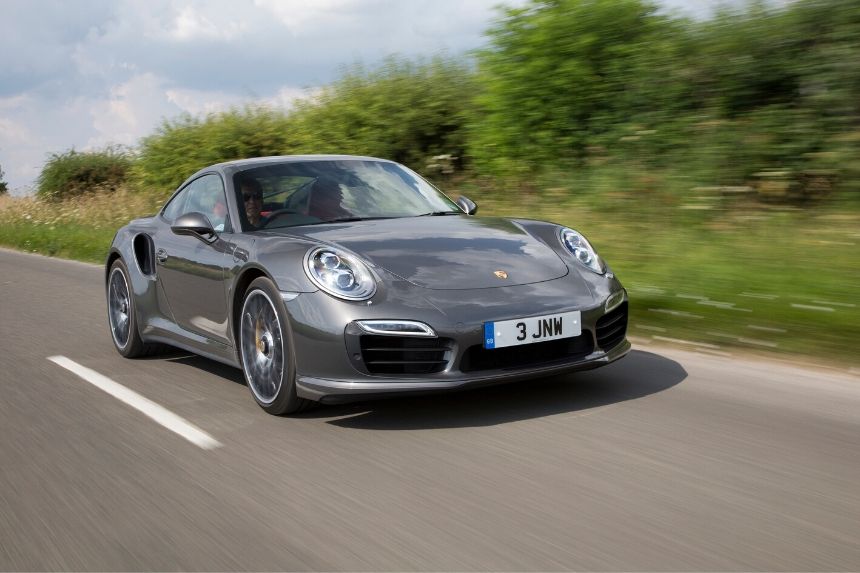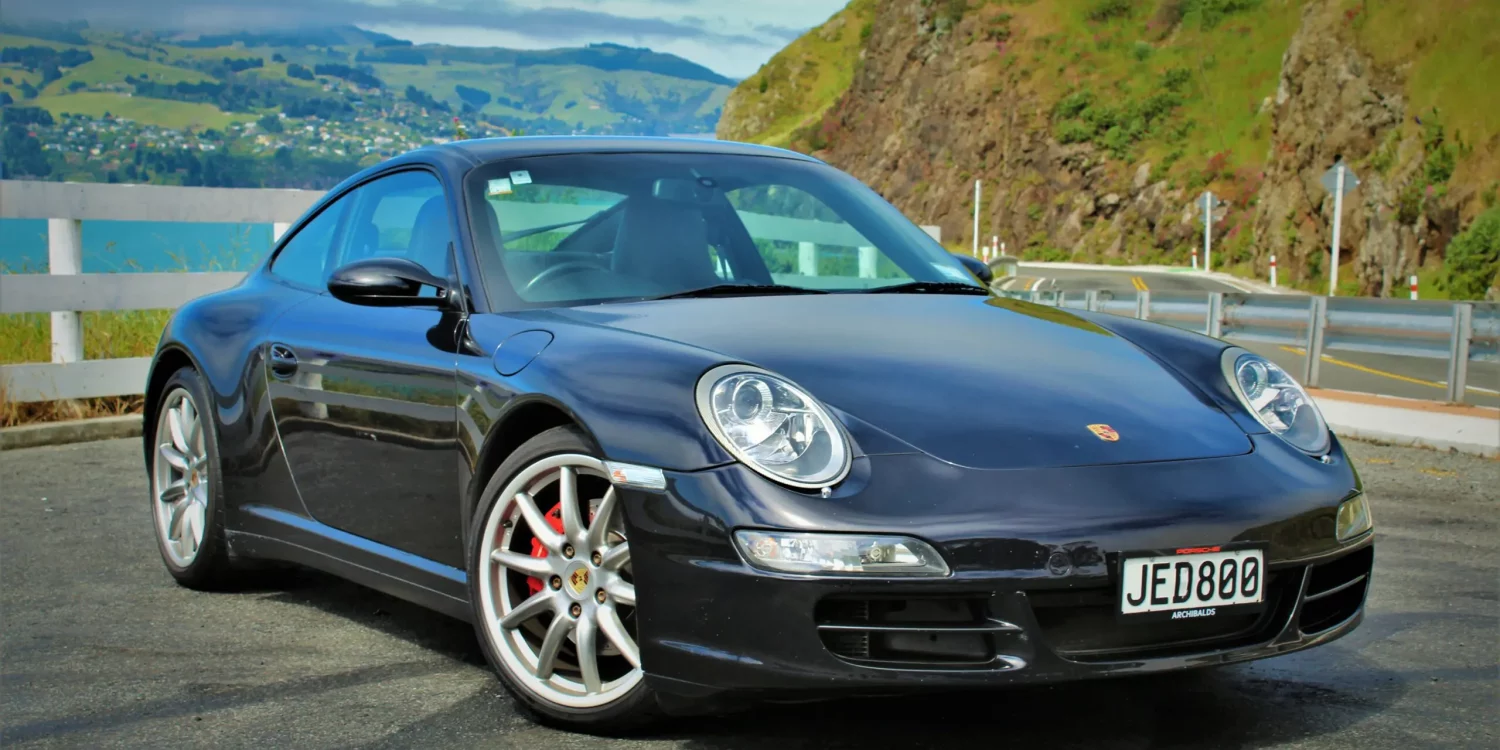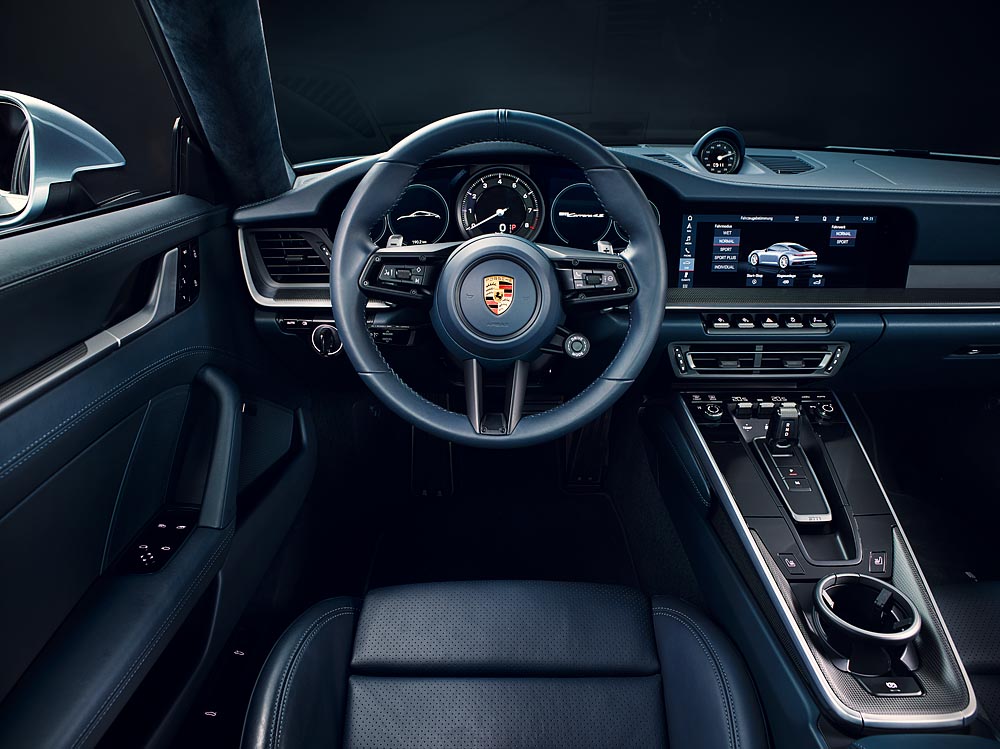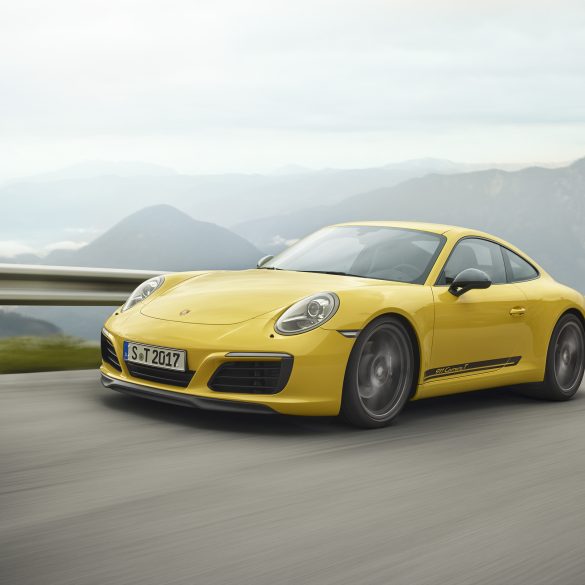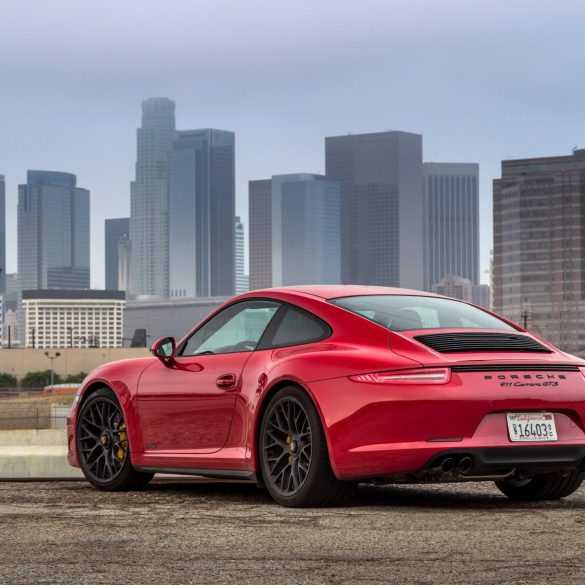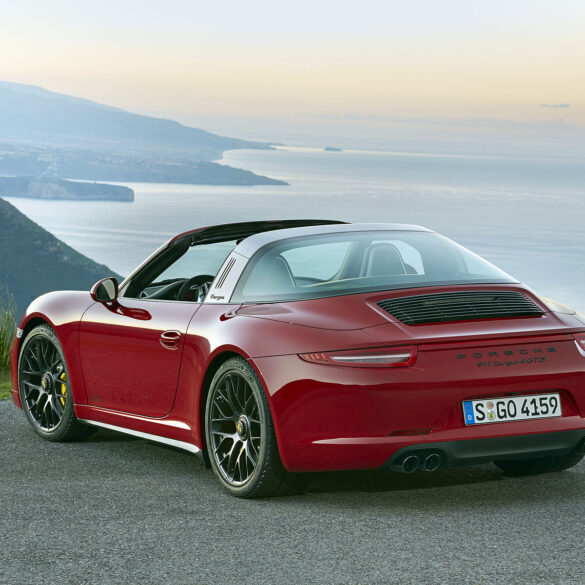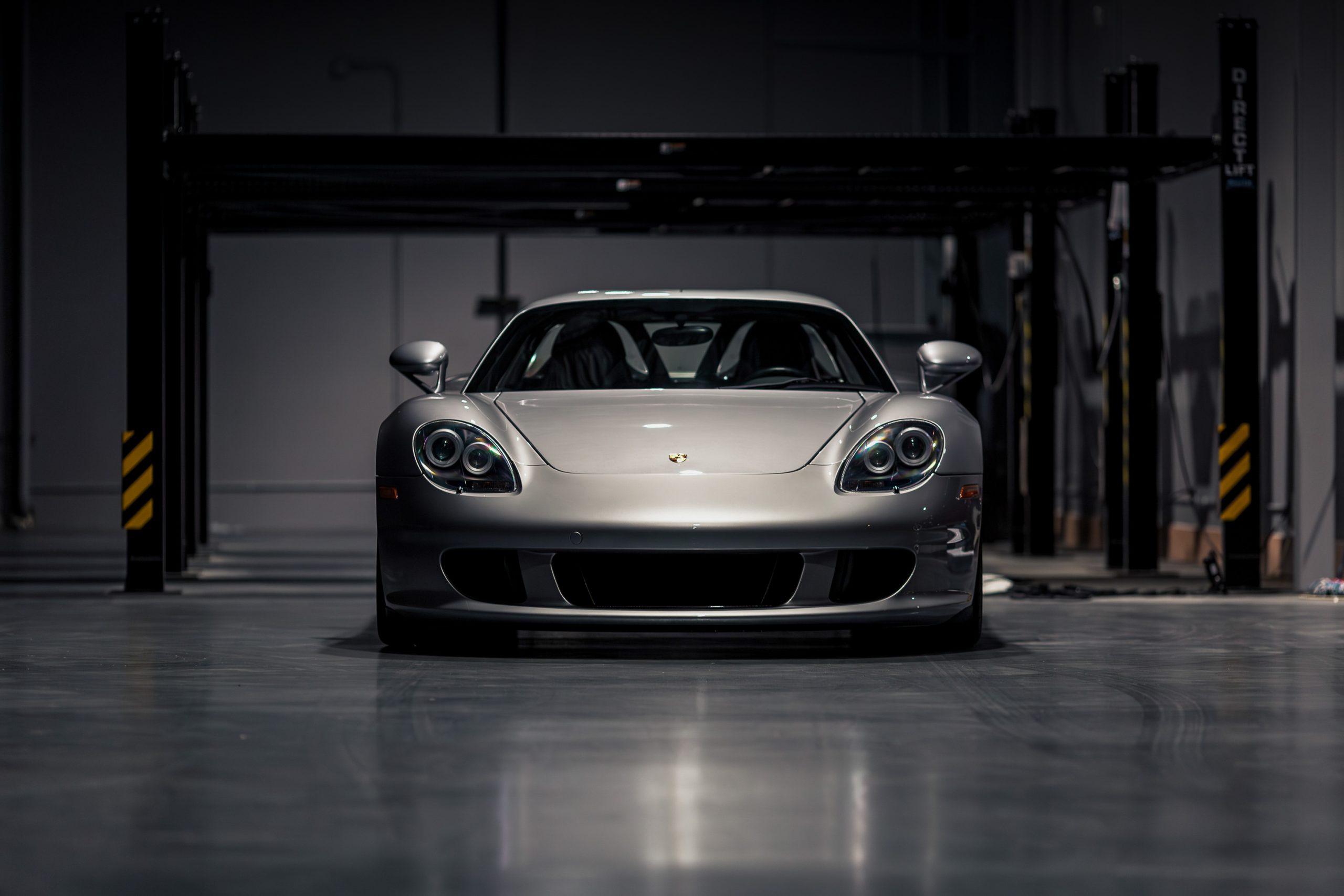
Model History
The Porsche 911 (991) generation, launched in 2012, represented one of the most transformative moments in the model’s evolution since its original debut in 1964. It was the first 911 built on an all-new platform since the 996, featuring a longer wheelbase, wider track, and an aluminum-intensive structure that significantly reduced weight while increasing rigidity. This new architecture allowed Porsche to elevate ride comfort and interior space without diluting the car’s sporting essence, and it marked the point where the 911 shifted decisively from compact sports car to high-performance, everyday-usable grand tourer.
Early 991.1 models (2012–2015) retained naturally aspirated flat-six engines, a decision that now places them in a particularly cherished position among enthusiasts. These versions combined classic Porsche response and sound with advanced chassis systems such as Porsche Active Suspension Management (PASM) and optional rear-axle steering, blending tradition and innovation in a way that felt both progressive and respectful of heritage. The introduction of the seven-speed manual gearbox and improved PDK transmission further advanced performance and drivability, bringing quicker shifts and greater efficiency.
In 2016, the 991.2 facelift ushered in one of the most controversial yet technologically important changes in modern 911 history: turbocharging across the Carrera range. While this move delivered dramatic improvements in torque and everyday performance, it also marked the end of naturally aspirated standard Carreras, shifting the character of the base 911 in ways that divided purists. However, Porsche balanced this with increasingly refined driving dynamics, greater efficiency, and even more sophisticated driver assistance and infotainment systems.
Throughout its production run, the 991 expanded into one of the most diverse 911 lineups ever, featuring variants such as the GT3, GT3 RS, Turbo, Turbo S, Targa, Speedster, and the ferocious GT2 RS. These special models further cemented the 991’s legacy as a generation that pushed the boundaries of what a 911 could be — both on road and track — while still honoring the unmistakable silhouette and engineering philosophy that define the Porsche name.
Why the 991 Generation Porsche 911 (2012 - 2019) is an Awesome Sports Car to Buy
The Porsche 911 (991) generation represents one of the most compelling and well-rounded sports cars you can buy if you’re looking for a blend of modern performance, timeless design, and everyday usability. Produced from 2012 to 2019, the 991 brought significant advancements in chassis engineering, interior refinement, and driving technology while retaining the unmistakable spirit of the 911. It feels more composed, more comfortable, and more capable than any previous generation before it, yet still delivers the emotional connection and rear-engined character that define Porsche ownership. For many buyers, it strikes an ideal balance between cutting-edge evolution and classic sports car soul.
From a driving perspective, the 991 is exceptional. The car feels planted, stable, and confidence-inspiring at speed, yet remains agile and communicative through corners. The steering is precise, the braking phenomenal, and the flat-six engine—whether naturally aspirated in earlier 991.1 models or turbocharged in the 991.2—offers remarkable performance across the rev range. It’s a car that can be comfortably driven every day, on long highway stretches or city commutes, yet transforms effortlessly into an exhilarating machine on winding roads or track days. Few sports cars manage to cover such a wide range of abilities so convincingly.
Ownership also makes strong practical sense. The 991 benefits from modern build quality, strong reliability, and more advanced safety and convenience features compared to earlier 911s. It provides a refined driving environment with improved infotainment, better ride quality, and more usable space, making it realistic as both a weekend toy and a daily driver. At the same time, certain models—particularly GT variants and well-specified early naturally aspirated cars—carry strong long-term desirability, giving buyers confidence that their investment is likely to remain resilient.
For those considering a 991, the appeal lies in its versatility. It offers the thrill and heritage of a classic Porsche 911 while embracing the performance and refinement expected of a modern sports car. Whether you prioritize raw driver engagement, cutting-edge technology, or long-term collectability, the 991 generation delivers an ownership experience that feels both exciting and deeply rewarding — making it one of the most complete and intelligent 911 purchases available today.
Porsche 911 (991) Models & Variants - A Quick Primer for Potential Buyers On The Variants & Specials To Think About.
We already have ultimate guide to the seventh generation Porsche 911 so we don't want to repeat everything here. Instead, we will give you a quick primer and summary about the main 991 911 variants, some of the core model year changes and we will talk about some special editions worth noting as you think about your potential purchase.
Key Variants & Differences
The Porsche 991 (2012–2019) marks one of the most transformative moments in the 911’s evolution, redefining what the modern sports car could be while preserving the core DNA that has made the 911 iconic for over six decades. It introduced an all-new platform with a longer wheelbase, wider track, and extensive use of lightweight materials, making it more stable, more sophisticated, and more capable than any previous generation. Within this technically advanced foundation sits one of the most diverse and strategically tiered lineups Porsche has ever created.
The 991 in Context: Two Distinct Eras
As with other modern 911s, the 991 is divided into two major phases:
991.1 (2012–2015) – Retained naturally aspirated engines across Carrera and Carrera S models, offering a classic, high-revving Porsche character.
991.2 (2016–2019) – Introduced turbocharged flat-six engines for all standard Carrera variants, significantly altering the driving character and performance profile.
This shift in philosophy is central to understanding the differences within the 991 range.
Core Carrera Models: Broad Appeal, Distinct Characters
Carrera
The entry-point 991 Carrera delivered a balanced blend of usability and performance. In 991.1 form, the 3.4-liter naturally aspirated flat-six produced 350 hp, offering crisp throttle response and an engaging, rev-hungry nature. With the arrival of the 991.2, the new 3.0-liter twin-turbo engine boosted power to 370 hp while dramatically increasing low-end torque and everyday drivability.
Carrera S
The Carrera S raised the stakes with a 3.8-liter engine in the 991.1 (400 hp) and a more aggressive 3.0-liter turbo unit in the 991.2 (420 hp). These models added PASM Sport suspension, larger brakes, and sharper dynamics, making them a popular choice for drivers seeking the ideal balance of performance and comfort.
Carrera 4 & 4S
The all-wheel-drive variants offer greater traction and stability, particularly in mixed conditions. With their wider rear track and more muscular stance, these models also bring enhanced visual presence, appealing to buyers who value both aesthetics and confidence-inspiring performance.
Transmission Evolution: Manual vs PDK
The 991 introduced a 7-speed manual transmission, while PDK became even more refined and dominant. PDK-equipped cars deliver blistering shifts and superior acceleration figures, though manual models remain cherished by purists for their tactile engagement.
Performance Models: The 991 at Full Song
991 Turbo & Turbo S
The Turbo models represent the technological pinnacle of the 991 platform. Featuring variable turbine geometry and all-wheel drive, power rose to 520 hp in the Turbo and 560 hp in the Turbo S (later increasing further in updated versions). These cars blur the line between sports car and supercar, offering devastating straight-line performance tempered by everyday usability.
GT3
The 991 GT3 marked a radical step forward with rear-wheel steering and track-focused engineering. It debuted with PDK only, later reintroducing a manual option due to overwhelming enthusiast demand. High-revving naturally aspirated engines and stripped interiors define its uncompromising ethos.
GT3 RS
An ultra-focused evolution of the GT3, the RS adds wider track, more aggressive aerodynamics, and reduced weight. It is a dominant force on track and a highly collectible modern Porsche icon.
GT2 RS
The crown jewel of the 991 lineup, the GT2 RS combines turbocharged power with rear-wheel drive and extreme aero. It became the most powerful roadgoing 911 of its era, representing Porsche’s most uncompromising performance statement.
Specialty & Lifestyle Variants
Carrera GTS
Bridging the gap between Carrera S and GT3, the GTS models offer enhanced power, sporty styling cues, and performance-focused tuning. Available across coupe, cabriolet, and Targa formats, the GTS became one of the most compelling all-rounders in the lineup.
Targa Models
The 991 revived the classic Targa name with a stunning automated roof mechanism, pairing vintage design influence with modern engineering. Available only with all-wheel drive, the Targa strikes a balance between style, luxury, and performance.
Speedster (991.2)
Limited and highly collectible, the 991 Speedster celebrates Porsche heritage with bespoke design and a purist driving experience rooted in emotional engagement.
Driving Dynamics & Character Differences
The longer wheelbase and improved chassis rigidity give the 991 exceptional stability and refinement, especially at high speeds. While some purists feel it softened the raw edge of earlier 911s, others appreciate its increased confidence and accessibility. The rear-axle steering on performance models enhances agility, disguising the car’s physical size with remarkable effectiveness.
Understanding the 991 Hierarchy
What makes the 991 generation so compelling is the sheer scope of its lineup. From refined daily drivers to track-focused monsters, from naturally aspirated purist icons to turbocharged torque machines, each variant offers a distinct interpretation of the 911 ethos.
Model Year Changes (2012-2019)
Here's a walkthrough of the Porsche 911 (991) model year changes from 2012 to 2019, highlighting what evolved, what really mattered, and how each year fits into the broader ownership and collector narrative.
2012 – Birth of the 991 Generation (991.1)
The 991 debuts with an all-new platform and a longer wheelbase, wider track, and extensive use of aluminum to reduce weight while improving rigidity. Styling became more modern and sculpted, while the interior took a major leap upmarket in layout and materials.
Key Changes:
All-new chassis and body structure
New 7-speed manual transmission introduced
Improved PASM suspension and electric steering
Naturally aspirated engines:
Carrera 3.4L (350 hp)
Carrera S 3.8L (400 hp)
PDK refined for quicker shifts and improved efficiency
This first year is celebrated for retaining the last naturally aspirated base Carreras with classic rev-happy character.
2013 – Lineup Expansion Begins
The range broadens to include more body styles and performance options, solidifying the 991 as a versatile platform.
Key Changes:
Introduction of Cabriolet models
Debut of Carrera 4 and Carrera 4S (AWD)
Launch of new-generation 991 Turbo & Turbo S
Improved standard feature lists
This year marks the true expansion of the platform’s identity and performance reach.
2014 – Performance Focus Intensifies
Porsche leans deeper into high-performance variants.
Key Changes:
Introduction of 991 GT3 (PDK only at launch)
Rear-axle steering debuts on GT3
Enhanced track-focused chassis tech
Continued refinement of systems and infotainment
The 991 GT3 caused a stir for its performance but also drew attention due to early engine reliability concerns.
2015 – Last Year of Naturally Aspirated Carreras
This year represents the end of the NA-era for standard 911 models.
Key Changes:
Final year of 3.4L and 3.8L NA Carrera engines
GT3 RS introduced
Minor technology and trim improvements
Interior updates and option refinements
For collectors, 2015 is considered one of the most emotionally engaging years of the 991.1.
2016 – Arrival of the 991.2 Facelift
A pivotal shift arrives as Porsche moves to turbocharging for all Carreras.
Key Changes:
Introduction of twin-turbo 3.0L flat-six across Carrera range
Power increases:
Carrera: 370 hp
Carrera S: 420 hp
Revised front and rear styling with updated lights
New PCM infotainment system
Improved steering calibration
This year represents the biggest character change in the 991 lineup.
2017 – Refinement & GTS Returns
The lineup matures further with focus on performance and usability.
Key Changes:
Introduction of Carrera GTS (450 hp)
Improved torque delivery and responsiveness
Continued enhancement of driving aids and tech
The GTS quickly becomes one of the most sought-after all-rounders.
2018 – Peak Performance Variants
Porsche pushes the envelope with more extreme performance models.
Key Changes:
Introduction of GT2 RS (700 hp)
Improvements to handling calibration and performance electronics
Continued refinement of PCM and driver-assist systems
The 991 platform reaches its absolute performance climax here.
2019 – Final Chapter & Farewell Models
The last year sees special editions and collector-focused sendoffs.
Key Changes:
Introduction of 991 Speedster
Final production year of the 991 platform
Highly refined build quality and feature execution
The 991 bows out celebrated as one of the most complete 911 generations ever produced.
What This Means for Buyers Today
2012–2015 (991.1): Best for purists who want naturally aspirated engines and traditional Porsche sound/feel.
2016–2019 (991.2): Best for buyers prioritizing modern performance, torque, technology, and efficiency.
2017–2019: Typically the most refined and desirable from a daily usability standpoint.
2015, 2018, 2019: Most collectible years due to final NA, GT2 RS, and Speedster availability.

991 Generation Porsche 911 Market Value & Pricing
The market for the Porsche 911 (991) (2012-2019) is showing a nuanced but clearly positive trajectory, with selective segments rising while broader availability keeps entry points accessible. According to recent listing data, average asking prices across the 991 range remain strong and are beginning to strengthen in the higher-end variants. Notably, models such as the 991.1 GTS, 991.2 Turbo, and GT3 versions are already experiencing upward pressure, as described by one market guide highlighting that “Prices are on the rise … in particular for the 991.1 GTS, Turbo, and GT3.”
That being said, market dynamics differ considerably depending on variant, generation (i.e., 991.1 vs 991.2), condition, and specification. While the headline performance models are appreciating, more conventional base Carreras—especially higher‐mileage or lesser‐spec examples—are experiencing more muted performance, and some signs of slight correction have been reported.
In practical terms for buyers and investors, the takeaway is clear: specialization and specification matter more than ever. A low-mileage, well-spec’d 991.2 Turbo or GT3 will likely benefit from future scarcity and strong demand, while a high-mile, widely configured base Carrera may be regarded more as a usable sports car than a future collectible. As the 991 generation continues to mature, the premium for rarity, condition, manual transmission, and performance derivatives is becoming increasingly distinct.
What Are 991 Porsche 911s Worth?
The price of a Porsche 911 from the 991 generation varies widely based on condition, originality, model variant, and desirability. Below is a breakdown of pricing into five categories—ranging from restoration projects to concours-level examples—along with insight into what buyers can expect in each bracket.
Project / High-Mileage Drivers
$30,000 - $55,000
At the bottom of the 991 market are cars that need significant work, have very high mileage (100k+ miles), deferred major servicing (clutch, suspension, brakes, cooling system), and possibly cosmetic or other mechanical issues. Most typically these are base Carrera models (Carrera or Carrera 4) with less desirable spec (e.g., automatic transmission, few options). While these can represent entry points into 991 ownership, they carry risk and budget for investment beyond the purchase price.
Good Daily/Driver Quality
$55,000 - $90,000
This bracket represents 991s that are in solid mechanical condition, have moderate mileage (say 50k–100k miles), appear well cared for and have decent service history though not pristine. These include well‐maintained Carreras, Carreras S, perhaps Carrera 4S models in everyday spec, and possibly early Turbo or GT3 models with higher mileage. Condition will be good but not show-car level; some cosmetic wear is acceptable. These are usable, enjoyable sports cars without paying top collector premiums.
Fully Sorted Enthusiast Examples
$90,000 - $150,000
Here we begin to see low‐ or moderate‐mileage examples (<50k miles), strong documented service history, desirable specs (manual gearbox, rare colours/options), and variants like Carrera S, Carrera 4S, early GT3s in good condition. These cars appeal to serious enthusiasts looking for balance between condition, performance and value. Are much higher quality and have stronger appreciation potential.
Desirable / Collector-Grade Drivers
$150,000 - $1300,000+
This tier includes low-mile, excellent-condition 991s with strong provenance, rare specifications, and performance models like later GT3 RS, Turbo S, special‐edition 991s. These cars are increasingly viewed as “modern classics” with investment intent. The price range is wide due to variant differences, but mid-$150k to $300k+ fits many very desirable examples and a lot of car for that kind of money. Won't be disappointed.
Limited Editions / Top Spec Variants
$3000,000 - $600,000+
At the very top of the 991 market are the most exclusive and rare models: e.g., GT2 RS, limited-edition models with ultra-low production and high performance, extremely low-mile highly original examples. These trade on scarcity, collector demand, and global interest rather than just purchase condition. Values here can be well over $300k and depending on provenance and spec may approach $500k or more.
Factors That Affect Value
Variant & Model Hierarchy
The single most powerful influence on value in the 991 market is the model itself. Base Carreras sit at the entry level, followed by Carrera S and GTS models, while Turbo, Turbo S, GT3, GT3 RS, and GT2 RS variants occupy a significantly higher tier due to performance, motorsport pedigree, and limited production. As the 991 matures, the price gap between standard models and these high-performance derivatives continues to widen.
Condition & Overall Presentation
Condition plays a decisive role in determining where a car sits within its variant tier. Immaculate examples with clean paint, unmarked interiors, tight mechanical behavior, and strong visual presentation command consistent premiums. Cars with cosmetic wear, poor detailing, or signs of neglect are discounted heavily regardless of their performance credentials.
Mileage
Mileage remains a strong psychological and market factor. Low-mileage examples are viewed as more collectible and often priced accordingly, particularly when supported by excellent condition. While well-maintained higher-mileage cars can still perform brilliantly, the market consistently places a premium on lower usage.
Service History & Maintenance Records
Comprehensive documentation provides tangible proof of responsible ownership. Full service records, evidence of routine maintenance, and proof of preventative care all contribute directly to value. Conversely, gaps in documentation introduce uncertainty and reduce buyer confidence, depressing resale potential.
Specification & Factory Options
Certain factory options dramatically shape desirability. Manual transmissions, Sport Chrono, PCCB braking systems, rare paint colors, carbon interior trim, rear-axle steering, and limited-edition packages enhance appeal and raise value. Well-specified examples consistently outperform sparsely optioned cars.
Originality vs. Modifications
As the 991 enters modern-classic territory, originality increasingly influences pricing strength. Factory-correct cars with original panels, trim, and components appeal to the broadest buyer base and retain value more effectively. Tasteful, reversible upgrades can still appeal to enthusiasts, but heavy or poorly executed modifications tend to suppress long-term value.
Ownership History & Provenance
Cars with fewer owners and long-term stewardship often inspire greater buyer confidence. Stable ownership history typically suggests careful maintenance practices and a higher level of care, enhancing both desirability and value consistency.
Rarity & Special Editions
Scarcity significantly increases pricing power. Limited-production variants, rare color combinations, and special editions generate strong collector interest and behave differently in the market, often appreciating faster and resisting market downturns.
Market Sentiment & Timing
Broader market forces also influence 991 values. Shifts in buyer preference toward naturally aspirated engines, manual gearboxes, and driver-focused experiences impact how different variants perform financially. Economic cycles and enthusiast trends further shape demand.
Future Collectability Perception
Finally, the perception of long-term desirability affects present-day pricing. 991s viewed as future classics — particularly GT models and rare-spec cars — command disproportionate interest, creating a widening gap between average and exceptional examples.
Together, these factors define where a 991 sits in today’s market and how it performs over time.
The most valuable examples are those where desirable variant, excellent condition, strong documentation, and standout specification intersect into a cohesive and compelling ownership story.
Investment Potential
Overall Investment Landscape
The Porsche 911 (991) represents a mature and increasingly collectible generation, yet one that still offers value opportunities. It has benefited from strong brand heritage, exceptional build quality and driver appeal which combined with relative age has allowed many models to become attainable modern classics. While not all 991s will appreciate dramatically, the overall market shows signs of stabilisation and selective growth — particularly for well-specified, low-mile examples and the higher-performance derivatives. As newer sports cars become more digital, heavier and less tactile, the analog performance and purity of the 991 increasingly resonate among enthusiast buyers and emerging collectors.
Core Carrera Models as Value Anchors
Standard Carrera models act as sensible entry points into 911 ownership rather than speculative investments. Well-maintained manual coupe examples with desirable options offer excellent driver value and long-term resilience rather than high-growth potential. They may not skyrocket in price, but they are less exposed to value erosion and provide a strong platform for appreciation should the broader market shift towards driver-focused analog cars.
Carrera S & Targa/4S: Mid-Tier Growth Prospects
Carrera S models (and Targa or wide-body 4S variants) represent a compelling blend of desirability and affordability. Their enhanced performance, optional wider body versions, manual transmission enumerations, and more aggressive styling place them ahead of standard Carreras in investment potential. As the market continues to separate “ordinary” 911s from “special” ones, these mid-tier variants are well positioned to benefit from increased attention.
Turbo & GTS Variants: Strong Performers
The Turbo and GTS models of the 991 generation offer both exceptional performance and growing recognition among collectors. The Turbo, especially in later 991.2 form with revised engines and torque figures, sits at the cusp of supercar capability while retaining 911 usability. GTS models provide enhanced performance, aesthetic upgrades and limited-run appeal, making them increasingly sought after. Together, these models represent strong investment prospects when low-mile, well-presented and in rare specification.
GT3/GT3 RS & GT2 RS: Top-Tier Collectible Tier
At the summit of the 991 investment pyramid lie the GT3, GT3 RS and ultimately GT2 RS models. The GT3 RS — especially the 4.0-litre version — combine racing technology, limited production and manual transmissions, setting them apart as the “driver’s driver” 911s. The GT2 RS takes performance to the extreme and as such sits firmly within blue-chip territory. For these cars, investment potential is extremely high — as long as condition, provenance and specification are exceptional.
Spec, Condition & History Now Critical
As the 991 continues to mature, specification, condition and history are increasingly decisive in investment performance. Low-mile cars, desirable configuration (manual, rare colours, sport seats, ceramic brakes), full documentation and original components are separating from the pack. The same model, different spec and history, may trade tens of thousands apart. This stratification means investment risk is higher for average-spec or poorly documented cars, and the upside is strongest for the best-sorted examples.
Long-Term Outlook & Collector Psychology
In the medium to long term, the 991 generation is well placed for appreciation, especially the models described above. The growing appetite for analog driving experiences, combined with reduced supply of excellent-condition examples and rising enthusiast demand, supports this. While not guaranteed, buyers positioning correctly — focusing on the right variant, exceptional condition and documentation — are likely to be rewarded. Conversely, selecting a common variant without premium spec or history reduces upside and increase risk.
In summary, the investment potential of the 991 generation is best accessed through select variants: manual Carreras for utility and long-term stability, Carrera S/4S/Targa for mid-tier growth, Turbo/GTS for strong performance upside, and GT3/GT2 RS for top-tier collector appeal. The key to success lies in detail, not simply the model name.
Recent 991 Generation Porsche 911 (2012-2019) Values & Market Sales Trends
Below, our friends at Classic.com chart recent sales and trends in the 991 gen Porsche 911 market. We've included the broad 991 generation and broken it out by 991.1 and 991.1 update. If you look at specific variants, check out the Classic.com website.
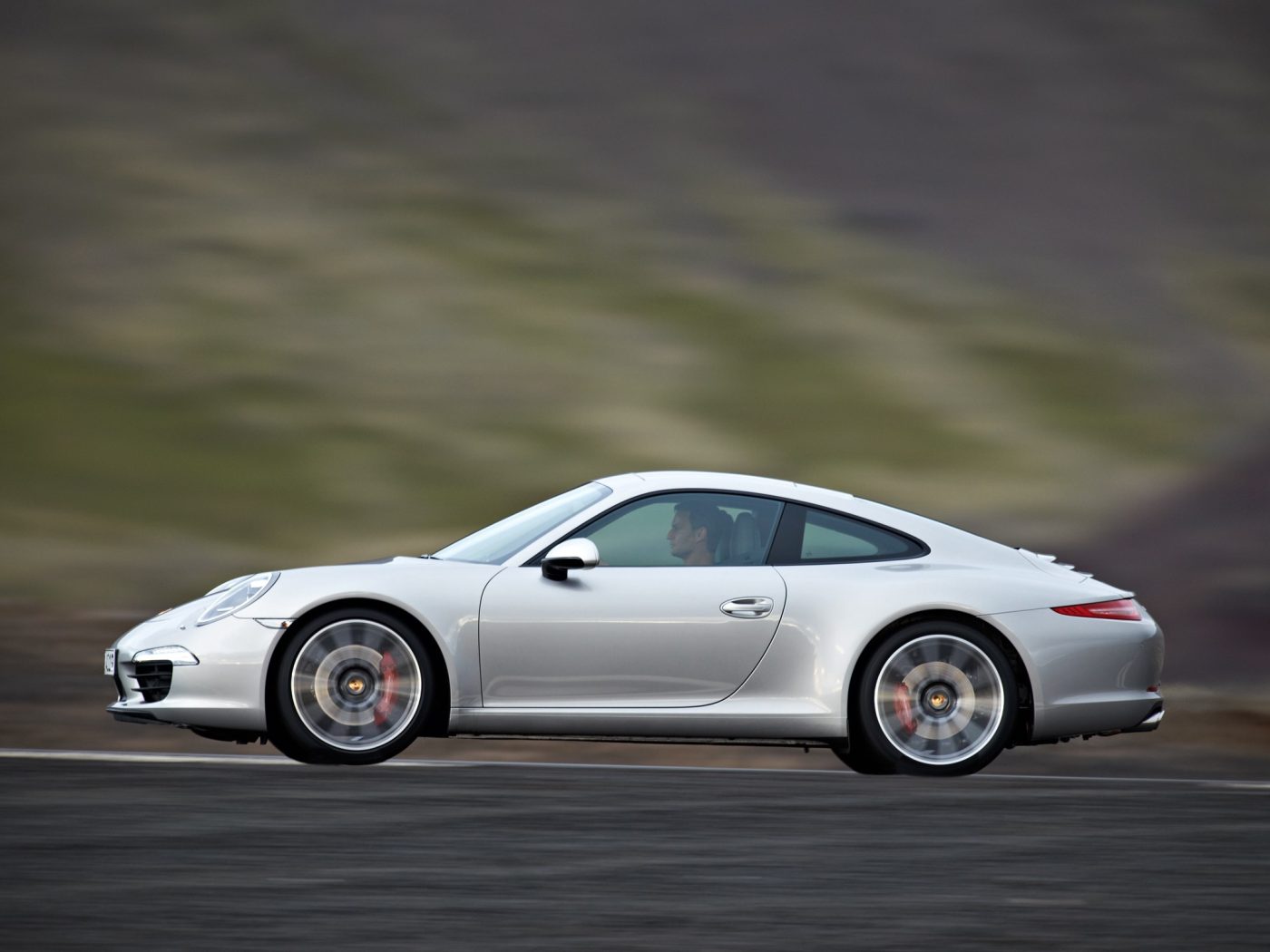
2012 - 2019 Porsche 911 (991) Driving Experience & What to Expect
The 991-generation 911 feels like the moment Porsche decided a 911 could be both a precision driver’s car and a genuinely polished modern GT. From behind the wheel, the first impression is how stable and composed it is: the longer wheelbase, wider track, and sophisticated suspension make the car feel incredibly planted, but it still has that unmistakable rear-engined “lean on the rear axle and go” character. The steering (electric for the first time in a 911) is lighter and smoother than older generations, but still accurate and confidence-inspiring. A lot of owners sum it up as “
effortlessly fast, but still very much a 911”
and that’s exactly the vibe: it’s less raw than a 997, but more grown-up and precise.
Performance and power expectations depend heavily on the variant, but nothing in the 991 range feels slow. Early 991.1 Carreras with naturally aspirated flat-sixes love to rev, with a smooth, progressive surge that builds toward the top of the tach—more “classic Porsche feel.” The 991.2 Carreras and S models, with their smaller but turbocharged engines, feel punchier in everyday driving: loads of mid-range torque, strong in-gear acceleration, less need to chase redline. A typical reaction from people stepping into a 991.2 for the first time is something like,
I barely tickled the throttle and it just surged forward.”
The S, GTS, Turbo and GT cars simply scale that experience up: more power, more grip, more headroom before you even approach the car’s limits.
Handling is where the 991 really shows its evolution. The car feels calm and unflustered at high speed, but still agile when you lean on it. PASM (adaptive dampers), optional rear-axle steering (on later and higher-spec cars), and the wider footprint give you huge confidence. Compared to earlier cars, you get more grip and stability, but Porsche still baked in enough movement that you can feel what the chassis is doing. Drivers often describe it along the lines of, “It shrinks around you the faster you go,” because the size and refinement fade into the background when you’re committed on a good road.
Variant choice really shapes the character. A rear-wheel-drive Carrera or Carrera S feels the most “classic 911”—lighter on its feet, a bit more playful if you provoke it, happy to rotate under power on corner exit. The Carrera 4 and 4S add all-wheel-drive security, especially in bad weather, and the wide-body 4S gives you that visual drama plus extra traction. Many people who daily a 991 in mixed climates end up saying something like,
The C4S is the one car I’d happily drive year-round.
GTS models sit in the sweet spot for many enthusiasts: slightly more power, sportier suspension settings, great spec as standard, and a bit more sense of occasion without jumping up to Turbo or GT money.
At the top of the tree, the Turbo and Turbo S transform the 991 into a supercar-rivaling missile. These feel almost absurdly fast in the real world, with huge torque, massive grip, and a kind of serene brutality—stamp the throttle and the horizon rushes at you while the car stays composed and quiet. People who come out of other fast cars often say things like,
I thought I knew what fast was until I drove a 991 Turbo S.
In contrast, the GT3 and GT3 RS are much more visceral: stiffer, louder, higher-revving, and more demanding. They’re the “I want a road-legal track car” choice—perfect if you want engagement and intensity, overkill if you just want a comfortable road 911.
As a daily driver, the 991 is very easy to live with. The cabin is comfortable, ergonomics are good, visibility is excellent for a modern sports car, and the ride (especially in normal PASM mode) is totally acceptable on real-world roads. PDK cars are smooth in traffic, the climate control works well, the infotainment is “modern enough,” and there’s usable luggage space front and back. Many owners genuinely treat them as all-weather, all-round cars:
It’s my commuter, my road-trip car, and my Sunday blast car
is a common sentiment. A manual-equipped Carrera or GTS gives you more interaction, while PDK maximizes ease and performance; both work, it’s just a question of personality.
As a weekend cruiser, the 991 feels special without being tiring. A naturally aspirated 991.1 Carrera S on a quiet back road has a lovely, progressively building soundtrack and a sense of flow; a 991.2 GTS has that muscular mid-range that makes short-shifting fun and effortless. Targa and Cabriolet versions turn the drama up a notch, trading a little sharpness for big gains in sense of occasion—roof down, flat-six behind you, and all the modern comfort you’d want.
For a potential buyer, the big picture is this: the 991 gives you a very wide band of capability. At one end, you can have a comfortable, refined, almost GT-like 911 that’s happy doing the school run or a 500-mile trip. At the other, you can have a focused GT3 that feels like a race car that just happens to wear plates. What ties them all together is the 991’s core traits: stability, speed, usability and that unmistakable 911 character. If you go in clear on what you want—rear-drive vs AWD, NA vs turbo, manual vs PDK—you’re very likely to come out of a 991 test drive thinking, in one way or another
This feels like more car than I’ll ever really need… in the best possible way.
Getting Real - Costs to Own & Maintenance
Costs to Own & Maintain a Porsche 911 (991)
Owning a 991-generation Porsche 911 is best described as premium but predictable when properly maintained. Compared to earlier 911s, the 991 benefits from modern engineering, improved reliability, and longer service intervals, but it is still a high-performance German sports car with correspondingly elevated running costs. The good news is that most expenses are well-understood and manageable with smart preventative maintenance and proper budgeting — making it one of the more sensible “exotic-adjacent” cars to own.
Routine Maintenance & Servicing
Annual servicing costs typically range from $1,200–$2,500 per year, depending on mileage and the level of work required. Minor services may include oil changes, filters, inspections, and fluid top-ups, while major services cover spark plugs, transmission service (PDK fluid), brake fluid, and more comprehensive checks. Porsche recommends servicing every 10,000–20,000 miles or annually, but most conscientious owners stick to yearly intervals regardless of mileage. Using Porsche specialists rather than main dealers can significantly reduce costs without compromising quality.
Wear Items & Consumables
Brakes, tires, and suspension components represent the most consistent ongoing wear costs. A full set of high-performance tires typically costs $1,500–$3,000, depending on brand and size. Brake pads and rotors can range from $2,000–$5,000+ for steel setups, with PCCB (ceramic) replacements climbing into five-figure territory if replacement is ever required. Suspension refreshes (dampers, bushings, arms) usually surface at higher mileage and can add several thousand dollars depending on scope.
Repairs & Unexpected Costs
While generally reliable, the 991 is not immune to occasional mechanical or electrical issues. Water pumps, coolant lines, PASM dampers, ignition coils, and electronic sensors can fail over time. Unexpected repair bills typically range from $1,000–$7,000, depending on severity. GT and Turbo variants amplify costs due to more complex systems and parts pricing. Preventive maintenance is key to avoiding expensive surprises.
Insurance Costs
Insurance varies widely based on location and driving history, but most owners can expect $2,000–$4,500 annually for full coverage. GT and Turbo models carry higher premiums due to replacement costs and risk profiles. Classic or limited-use policies can reduce costs for low-mileage or weekend-only cars.
Fuel & Running Costs
The 991 runs happily on premium fuel and averages anywhere from 18–25 mpg depending on driving style and variant. Annual fuel spend will vary greatly but is generally manageable relative to the car’s overall ownership profile. Routine running costs, excluding maintenance, are not dramatically higher than other high-end performance cars in its class.
Ownership Stage & Age-Related Costs
As 991s continue to age, owners should anticipate rising costs tied to suspension refreshes, brake overhauls, cooling system updates, and drivetrain maintenance. Early 991.1 cars now entering higher mileage brackets may need more involved maintenance, while newer 991.2 models benefit from more robust long-term reliability but still command higher parts costs.
Parts Availability & Support
Parts availability for the 991 is generally excellent. Porsche Classic support and a strong independent specialist network ensure that most components are readily available. However, OEM parts pricing is premium, and high-end or GT-specific components can be eye-wateringly expensive. Aftermarket performance and maintenance parts help reduce costs without sacrificing quality when chosen wisely.
Real-World Annual Ownership Estimate (General Use)
For a well-maintained 991 driven 5,000–8,000 miles per year:
Routine maintenance & wear: $2,000–$4,000
Insurance: $2,000–$4,500
Fuel & misc: $1,500–$3,000
Occasional repairs (averaged): $1,000–$2,500
Estimated annual ownership range: $6,000 – $12,000 per year for most owners (Considerably higher for GT/Turbo heavy-use scenarios)
Final Thoughts for Buyers
The 991 is not a cheap car to run, but it is a remarkably stable and predictable one for its performance level. The key to satisfying ownership lies in buying the best example you can afford, prioritizing full service history, proper maintenance habits, and realistic budgeting. Compared to many modern supercars, the 991 offers an exceptional blend of usability, reliability, and emotional reward — making its ownership costs not just manageable, but entirely justifiable for the experience it delivers.
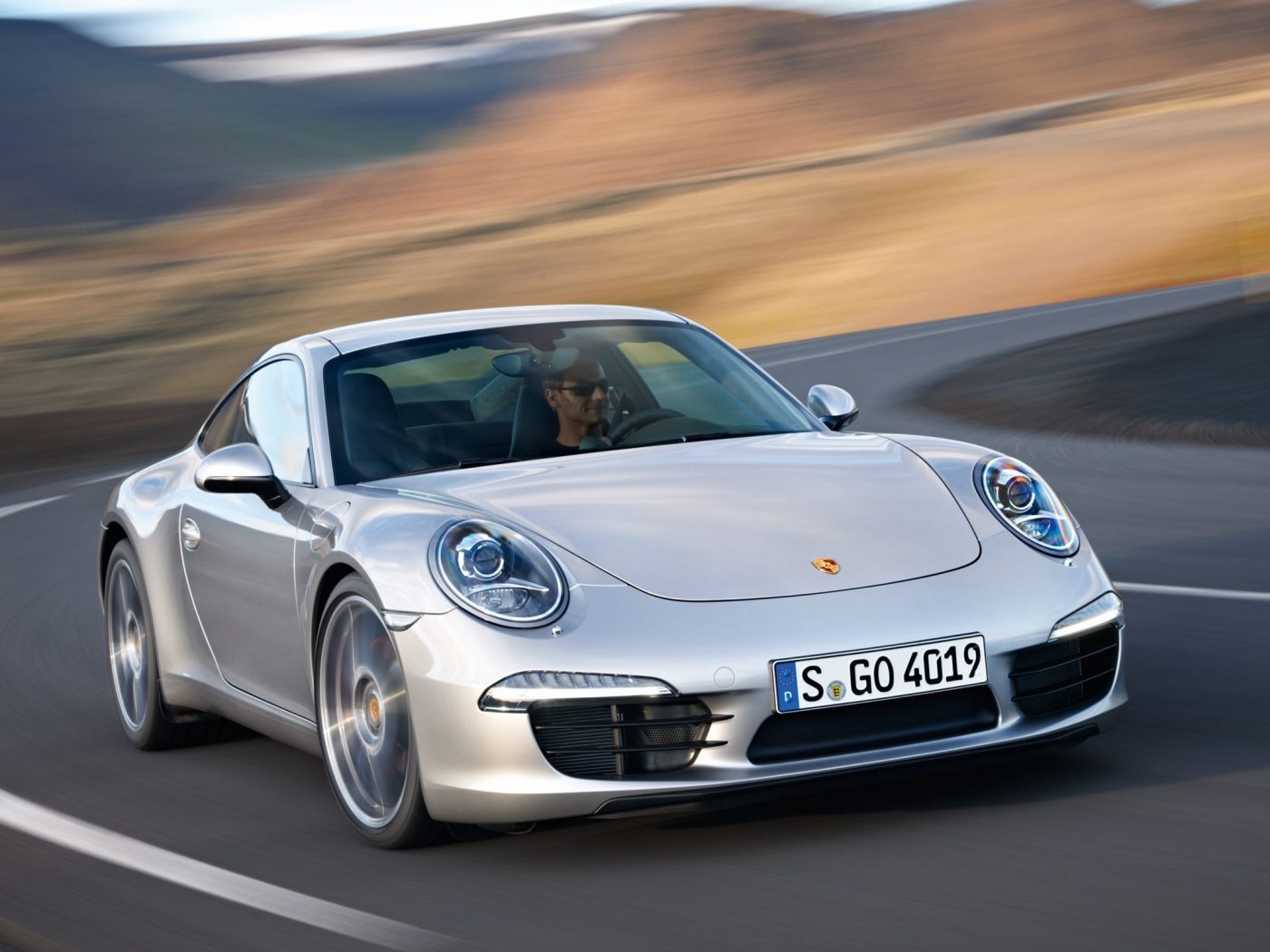
Other Key Buying Considerations & What to Look For
Ensuring Performance, Authenticity, and Long-Term Enjoyment
When purchasing a Porsche 911 (991), the real difference between a dream ownership experience and a frustrating one lies in the details beneath the surface. While model choice and headline specs draw attention, it is the underlying condition, mechanical integrity, and authenticity that ultimately define long-term satisfaction. A well-vetted 991 should feel cohesive, mechanically healthy, and true to its original intent, offering both dynamic excellence and confidence in future ownership. This section focuses on the critical areas that determine how well a car will perform, how reliably it will age, and how secure your investment will be.
Engine: Health, Behavior & Longevity
The 991’s flat-six engines are generally durable and well-engineered, but they still require meticulous inspection. A healthy engine should start cleanly, settle into a smooth idle, and reach operating temperature gradually without hesitation or fluctuation. Pay close attention to any ticking, knocking, excessive valve noise, or irregular vibration. These can indicate anything from minor wear to more serious internal issues. Look for evidence of consistent oil changes and high-quality fluid use, as neglect here can shorten engine life significantly.
On 991.1 naturally aspirated models, the engine should rev freely and progressively right through the upper range, producing a smooth, linear surge of power and a crisp exhaust note. On 991.2 turbocharged variants, expect strong mid-range torque and seamless boost delivery without lag spikes or abrupt power delivery. Any signs of boost hesitation, inconsistent acceleration, or warning lights should trigger deeper investigation. A pre-purchase inspection should ideally include diagnostic scanning, borescope evaluation if necessary, and oil analysis to assess internal wear and contamination. These steps are invaluable in avoiding costly surprises.
Transmission: Manual vs PDK
Both transmission options in the 991 are excellent, but each carries different ownership considerations. Manual gearboxes should feel direct and consistent, with smooth clutch take-up and no grinding between gears. A heavy pedal, slipping sensation, or notchy shift action may indicate clutch wear or gearbox stress. Clutch replacement can be expensive, especially on higher-performance variants, so confirming its health is crucial.
PDK systems should deliver instant, seamless gear changes in both automatic and manual modes. Any hesitation, clunking, delayed engagement, or warning codes suggest potential issues that can lead to significant repair costs. Confirm that PDK fluid changes and software updates have been carried out according to Porsche schedules. A well-maintained PDK should feel almost telepathic in operation, enhancing both performance and drivability.
Suspension & Brakes: Ride Quality and Wear
The 991's suspension system plays a pivotal role in its dynamic character, and wear here dramatically alters driving feel. Check for uneven tire wear, clunking noises over bumps, excessive body movement, or harsh ride behavior — all signs of worn dampers or bushings. PASM dampers should adjust ride firmness effectively, not feel stuck in overly stiff or overly soft modes.
Brake assessment is equally important. Standard steel brakes should deliver firm, progressive braking without vibration or squealing, while PCCB ceramic systems require close inspection due to their extreme replacement cost. Check for scoring, cracking, or uneven wear. A spongy pedal or steering vibration under braking may indicate warped rotors or worn components needing immediate replacement.
Body & Exterior Condition
Visually inspect every panel for consistent paint finish, smooth reflections, and aligned panel gaps. Inconsistent paint depth or mismatched textures may suggest repainting or accident repair. While minor stone chips are normal on sports cars, signs of poor repair work such as overspray, uneven edges, or misaligned trim are red flags.
Examine underbody panels for corrosion, excessive damage, or signs of poor jacking practices. Check wheel condition and alignment alignment consistency. For Targa and Cabriolet models, inspect roof mechanisms carefully for smooth operation and water tightness, as repairs can be costly and complex.
Interior & Cabin Quality
The interior tells a powerful story about how the car has been treated. Inspect seat bolsters, steering wheel leather, shift knob, pedal wear, and switchgear. Excessive wear relative to mileage may indicate harder use than advertised. Ensure all electronics operate correctly — infotainment, climate control, drive mode switches, sensors, seat motors, and digital displays all function as intended.
Look for factory finishes and verify originality wherever possible. Modified interiors or aftermarket elements often reduce long-term appeal and raise concerns about overall vehicle care.
Authenticity & Documentation
Confirm VIN plates, option codes, and documentation to ensure the car matches factory specification. Original window stickers, service invoices, maintenance logs, and ownership history enhance confidence and add real market value. A car with clear provenance, consistent service intervals, and documented care is always more desirable than one with gaps or ambiguity.
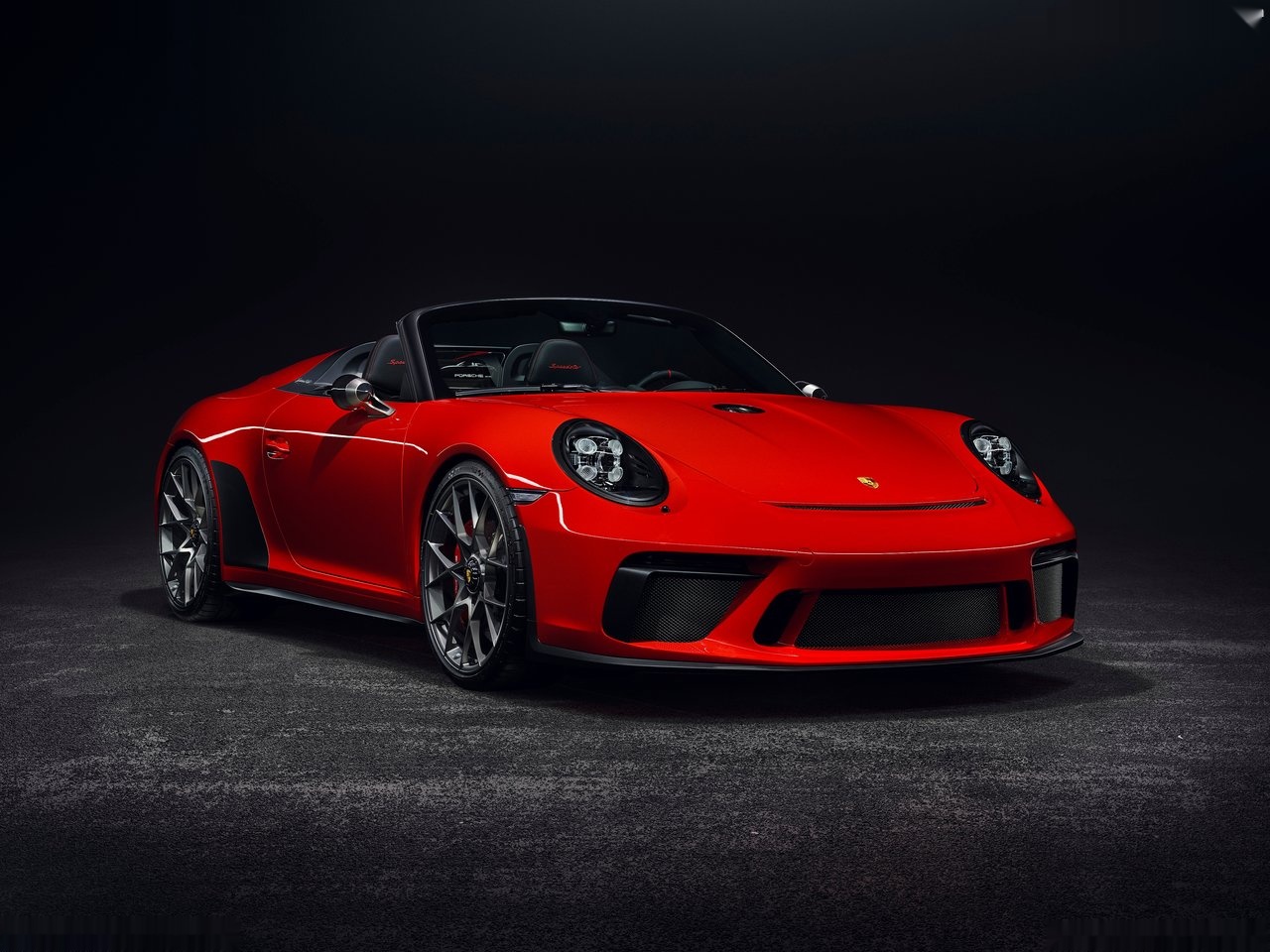
Common 991 Gen Porsche 911 Problems
What Buyers Should Know
Here is an overview of the most common Porsche 911 (991) problems, with context around how serious they are, which models they affect, and what they mean for real-world ownership. While the 991 is generally considered one of the most reliable modern 911 generations, it is not immune to recurring issues — and understanding them is key to buying wisely.
PDK Transmission Issues (Mechatronics, Clutch Behavior & Software Irregularities)
The PDK transmission is one of the most impressive dual-clutch systems in the industry, but when problems arise, they can be expensive and complex to resolve. Early warning signs include hesitation when pulling away, rough low-speed shifts, intermittent clunking when selecting Drive or Reverse, or inconsistent throttle response during light acceleration. These symptoms may be linked to wear within the mechatronic unit, clutch pack degradation, or outdated transmission software.
Although full failure is rare, ignoring early symptoms can lead to expensive repair bills exceeding $6,000–$10,000 in worst-case scenarios. Buyers should ensure fluid changes were carried out on schedule (typically every 40k miles) and test-drive the car in both normal and sport modes under varied conditions. Properly maintained PDK units should feel seamless and immediate, almost invisible in operation.
PASM Suspension Wear & Deterioration
Porsche Active Suspension Management contributes heavily to the 991’s dual personality of comfort and performance, but it is not immune to age-related wear. Over time, dampers lose effectiveness, bushings degrade, and control arms develop play. Common symptoms include knocking noises over uneven surfaces, excessive harshness, vague steering feel, uneven handling response, or unsettled movement mid-corner.
A neglected suspension doesn’t just affect comfort — it reduces grip, stability, and braking confidence. Replacing worn PASM dampers, arms, and bushings can easily exceed $4,000–$8,000 depending on scope and whether OEM parts are used. Buyers should pay attention to ride feel and check for uneven tire wear that signals geometry or suspension degradation.
Water Pump & Cooling System Failures
The water pump is considered a wear item across modern Porsche platforms, and the 991 is no exception. Failures often emerge between 50,000 and 80,000 miles and manifest as coolant leaks, overheating warnings, fluctuating temperature readings, or visible residue around the front of the engine bay.
If not replaced in time, a failed pump can lead to overheating and potential engine damage. Replacement is relatively straightforward but still a notable expense, typically ranging from $1,200–$2,000 depending on labor rates and additional cooling components replaced alongside it. Smart buyers look for documentation showing proactive replacement.
Coil Pack & Ignition System Failures
Ignition coil packs degrade over time due to heat exposure, particularly in high-performance driving environments. When failing, the engine may misfire under load, suffer from rough idle, experience power loss, or trigger a check engine light. While coil packs themselves are relatively inexpensive, neglecting them can strain catalytic converters or damage other ignition components.
Buyers should check service records for recent ignition work and be cautious if the engine feels hesitant or rough under acceleration. Replacing a full set usually costs between $800–$1,500, depending on whether plugs are done at the same time.
Premature Tire Wear & Front-End Geometry Issues
The aggressive factory alignment settings on the 991 deliver excellent cornering performance but can accelerate inner-edge tire wear, particularly on the front axle. Many owners are surprised by how quickly performance tires wear, especially if the car is used enthusiastically or driven on imperfect roads.
Uneven wear may also point to worn suspension components or poor alignment practices. Over time, this can compromise stability and increase operating costs significantly. Regular alignment inspections are critical, especially before purchasing.
PCM Infotainment & Electronic System Glitches
The Porsche Communication Management system, particularly in early 991.1 models, can suffer from sluggish performance, freezing screens, Bluetooth connectivity dropouts, navigation crashes, or unresponsive touch controls. Software updates often solve minor issues, but full unit replacements can be expensive.
Electrical gremlins may also affect parking sensors, adaptive lighting, seat controls, or digital modules. While rarely catastrophic, diagnosing electrical issues can be time-consuming and costly if ignored.
Roof Mechanism Failures (Targa & Cabriolet)
Cabriolet and Targa versions introduce additional failure points via motors, hydraulic components, sensors, and seals. Roofs that open slowly, fail to latch properly, or emit unusual noises during operation may indicate mechanical wear or misalignment.
Water ingress around roof seals is another known issue and can lead to interior damage or electrical complications. Repairs can be expensive and should be carefully inspected during purchase.
Engine Sensors & Check Engine Warnings
The 991 relies heavily on sensor networks to regulate performance and emissions. Failures of oxygen sensors, pressure sensors, temperature sensors, or MAP sensors can trigger check engine lights and performance inconsistencies. These are usually isolated issues but can mount up over time. While individually minor, persistent sensor failure patterns often indicate broader maintenance neglect or electrical system stress.
GT3-Specific: Early 991.1 Engine Recall History
The first generation of 991 GT3 models suffered from a serious connecting rod bolt defect that led to engine fires. Porsche implemented a full recall campaign and replaced affected engines. Any GT3 purchase should include documentation verifying that recall work was completed and that the engine was either replaced or officially upgraded. Post-recall cars are largely safe, but documentation is critical.
Exhaust Valve & Actuator Failures
Porsche Sport Exhaust systems can develop failing valves or seized actuators, leading to inconsistent exhaust note, rattling sounds, or fixed-open or closed valve positions. While the car remains drivable, repairs can be costly due to labor complexity and component pricing.
Interior Wear & Cabin Degradation
Common wear points include seat bolsters, steering wheel leather shine, peeling trim, worn buttons, and scratched center console surfaces. Excessive wear relative to mileage can speak volumes about how the car was treated. Restoring interior condition to factory quality can be surprisingly costly and may affect resale value.
How Serious Are These Issues Really?
Unlike the IMS or bore-scoring fears that defined earlier generations, the 991’s problems are typically predictable, wear-related, and manageable. Properly maintained cars with strong documentation and preventative maintenance rarely experience catastrophic failure. Where issues do arise, they are most often linked to deferred servicing or poor ownership discipline.
Smart Buyer Reality Check
A full pre-purchase inspection remains non-negotiable. Buyers should aim to review:
Diagnostic error codes
Service history consistency
Cooling and suspension health
Transmission condition
Recall usage and updates
Evidence of proper servicing intervals
Final Buyer Verdict
The Porsche 991 is one of the most reliable modern 911 generations but still demands careful scrutiny. Its common problems are not reasons to avoid the model — they are simply realities to understand. For buyers who approach ownership with diligence and informed expectations, the 991 offers a richly rewarding experience with manageable risk and exceptional long-term enjoyment.
Buying A 2012 - 2019 Porsche 911 (991) FAQs
Here are all the questions we've received from readers considering a Porsche 991 for their garage
Is the Porsche 991 reliable for daily driving?
Yes — the Porsche 911 (991) is widely regarded as one of the most reliable modern sports cars you can confidently use as a daily driver. Compared to earlier generations, the 991 benefits from improved build quality, more durable engine architecture, and refined electronics, making it far more forgiving in day-to-day use. When properly maintained, a 991 will handle commuting, long-distance travel, and even year-round driving with remarkable consistency, all while still delivering the performance and character expected of a 911.
That said, it remains a high-performance vehicle, not an economy car, so maintenance discipline is essential. Regular servicing, proper warm-up habits, and attention to wear items like brakes, tires, and suspension are key to long-term reliability. Owners who follow Porsche-recommended service intervals and address minor issues early typically report years of trouble-free daily use, reinforcing the 991’s reputation as a truly usable performance icon.
Just how important are service records and ownership history?
Service records and ownership history are absolutely critical when buying a Porsche 911 (991) — not just for peace of mind, but for protecting both your ownership experience and the car’s long-term value. A complete, well-documented service history shows that the car has been properly maintained, serviced on schedule, and cared for by owners who took responsibility seriously. It confirms that essential work such as oil changes, brake servicing, fluid replacements, software updates, recalls, and major maintenance jobs were completed correctly and on time. Without this documentation, even a visually perfect 991 becomes a gamble, as hidden neglect can lead to costly mechanical failures later.
Ownership history is equally revealing. A car with fewer, long-term owners often reflects consistent care and a stable maintenance approach, whereas frequent ownership changes can sometimes indicate unresolved issues or harder usage. A continuous paper trail of invoices, service stamps, and ownership records not only reduces risk but also strengthens resale value significantly. In today’s increasingly discerning market, buyers are far more willing to pay a premium for a 991 with transparent, traceable history — and will heavily discount cars with gaps, inconsistencies, or unclear provenance.
Is the 991 better than the 997 for reliability?
Yes — in many respects the Porsche 911 (991) generation is more reliable than the Porsche 911 (997) generation, but with important caveats that any buyer needs to understand. On balance, the 991 benefits from more modern engineering, cleaner production, fewer known design-critical issues, and a platform that’s had longer to mature and stabilise. For example, one enthusiast summed up their experience:
“The 991 is probably better suited for daily duties … more refined cabin, quieter …”
Here’s how that assessment translates into practical terms:
Where the 991 has the edge
The 991 addresses many of the systemic concerns that afflicted earlier 911s. Its chassis uses a more advanced aluminium-steel mix, the suspension geometry is more refined, and numerous reliability refinements were built in from day-one. For instance a reviewer noted:
“The 991 is a generation on from the 997. … The interior in particular is a significant step up in design.”
Because the 991 arrived later, many known weak links (in earlier models) were already understood and mitigated. This means fewer unknowns for a buyer today: better electronics architecture, improved manufacturing tolerances, and more robust components.
Owners often report that the 991 is easier to live with on a day-to-day basis — better ride comfort, more refined cabin, and fewer “quirky” behaviour issues than some 997s. One owner put it simply:
“The 991 is fantastic … as a daily it won’t skip a beat, modern, fast, comfortable…”
But there are caveats
The 997 is by no means unreliable. In fact, the later 997.2 models are highly regarded for mechanical robustness, especially when properly maintained. One forum post noted:
“The 997.2 and the 991 both use the MA1 engine and it’s similarly reliable in both.”
Reliability always hinges on maintenance, usage, and ownership history more than generation alone. A high-mileage, neglected 991 can be riskier than a well-maintained 997.
Some 991 models introduce their own complexity: for example, turbocharging (in 991.2 models), electronic steering assist, more sensor-heavy systems, and larger size/weight can change how problems manifest. So while reliability may improve on average, issues still arise and may cost more to fix due to greater system complexity.
How does the 991 compare to the 997?
The Porsche 911 (991) and 911 (997) represent two very different interpretations of what a modern 911 should be. The 997 is often seen as the last “classic-feeling” 911 — compact, tactile, and more mechanically raw — while the 991 marks the moment Porsche fully embraced modern refinement, technology, and broader usability. Neither is inherently better; they simply appeal to different types of drivers, and understanding that distinction is key when choosing between them.
Driving Feel & Character
The 997 delivers a more traditional, analogue driving experience. Its hydraulic steering provides richer road feedback, the car feels smaller around you, and there’s a sense of mechanical involvement that purists deeply value. The 991, by contrast, feels more composed, stable, and polished. Its electric steering is precise but slightly more filtered, and the wider track and longer wheelbase give it greater high-speed confidence but slightly less intimacy. Many drivers describe the difference as the 997 feeling more “alive,” while the 991 feels more “accomplished.”
Performance & Capability
The 991 is objectively the more capable car. It is faster, more stable, and more forgiving at the limit, especially on modern roads or track days. Technology like rear-axle steering, improved PASM suspension, and more advanced traction systems allow the 991 to extract performance with less drama. In contrast, the 997 can feel more demanding but also more rewarding for experienced drivers who enjoy managing weight transfer and rear-engine dynamics manually.
Comfort & Daily Usability
This is where the 991 truly pulls ahead. The cabin is more spacious, quieter, better insulated, and more ergonomic. Ride quality is improved, technology is more modern, and long-distance comfort is significantly enhanced. The 997, while still perfectly usable as a daily driver, feels more old-school in comparison — both in layout and refinement. If regular commuting, long trips, or weekend touring are part of the ownership plan, the 991 is clearly the easier car to live with.
Technology & Interior Quality
The 991 represents a major leap forward in interior design and infotainment. Materials feel more premium, the center console is more modern, and the technology suite is far more in line with contemporary expectations. The 997’s interior is charming but dated — more functional than luxurious by today’s standards. For some buyers, that simplicity is a virtue; for others, it highlights the car’s age.
Reliability & Ownership Experience
While both generations can be reliable with proper care, the 991 benefits from more evolved engineering and addresses several of the systemic concerns associated with earlier water-cooled 911s. It tends to be more predictable in daily use and less quirky in terms of electronic behavior and mechanical wear patterns. That said, a well-maintained 997.2 can be just as dependable as a 991 — the difference lies more in refinement and consistency than raw mechanical toughness.
Emotional Appeal & Identity
The 997 feels closer to the classic Porsche ethos — more compact, more visceral, more mechanical. The 991 feels more like a modern GT sports car that still carries the 911 DNA. Buyers who crave nostalgia and purity often gravitate toward the 997, while those seeking performance, comfort, and modern usability lean toward the 991.
The Bottom Line
Choose the 997 if you want a rawer, more engaging, “old-school” 911 experience with greater mechanical feedback and a stronger connection to classic Porsche character. Choose the 991 if you want a more refined, capable, and versatile sports car that balances thrilling performance with modern comfort and everyday usability. Both are outstanding generations — the decision ultimately comes down to whether you value emotion and analog feel or performance and refinement more in your Porsche ownership experience.
How does the 991 compare to the 992?
When comparing the 991 and 992 generations of the Porsche 911, the story is one of evolution rather than revolution. While both retain the unmistakable silhouette and rear-engine configuration that define a 911, the 992 pushes further into modern territory in terms of technology, size, performance and comfort — whereas the 991 offers arguably more visceral connection, lighter feel and more analogue character. As one reviewer noted: “Both are unmistakably 911 in their feel, but the 992 is sharper, faster, and more forgiving at the limit … the 991, especially in its earlier naturally aspirated form, is the more analogue of the two.”
Size, Feel & Driver Engagement
The 992 is larger and more planted — with a wider track, more rigid body, and advanced chassis systems — which results in impressive stability and ease of performance. For example, one Reddit owner who moved from a 991.2 to a 992 commented positively on the ergonomics and refinement: “The seating position is very low in the 992… For me, ergonomically it’s vastly superior to the 991.2.” By contrast, the 991 feels slightly more compact and intimate, which some purists argue enhances its emotional appeal and the directness of the driving experience.
Performance, Technology & Evolution
Under the hood and within the drivetrain, the 992 enlarges the performance envelope while adding more tech-assist systems, refined transmissions, and greater tool-box capabilities. For instance, the 992 introduced an 8-speed PDK (versus 7-speed on the 991) and greater torque output in many variants. The 991, meanwhile, offers simpler systems in many variants (especially 991.1) and for some drivers this translates into a purer, more mechanical feel. Some say the 991 delivers greater satisfaction for those who value driver input over automated refinement.
Usability & Daily Comfort
In the day-to-day sense, the 992 clearly has the upper hand. Better noise insulation, updated infotainment systems, more spacious cabin, and more advanced driver assistance features make it more comfortable as a daily driver or long-distance touring machine. The 991 remains more connected, perhaps more “driver-oriented,” but may feel a step behind in terms of refinement and modern comfort features compared to the 992.
Emotional & Collector Considerations
From a collector perspective, the 991 may edge ahead in terms of emotional engagement, authenticity and appeal to traditionalists because of its comparatively analog feel and simpler architecture. The 992 — while technically superior — might be seen by some as less emotionally raw and more engineered. One piece put it succinctly: “The 992 is stunning … but it lacks the unreasonableness that earlier models exuded.”
The Bottom Line
If your priority is cutting-edge performance, modern comfort, maximum capability and daily practicality, the 992 is the stronger choice. If you value driver involvement, emotional feedback, simplicity of mechanics and classic 911 character, the 991 remains highly compelling and may offer ‘more car’ in a fundamentally engaging sense.
Should I Be Concerned About Buying a Modified 991?
The short answer is: it depends on the type, quality, and intent of the modification. A modified 991 is not automatically a red flag, but it does require a more cautious and discerning eye than a factory-original car. In today’s market, originality still carries the strongest appeal for long-term value and broad buyer confidence — especially as the 991 evolves into modern-classic territory. However, well-executed, professionally documented modifications can still make for an outstanding ownership experience if your priority is driving enjoyment rather than future collectability.
Tasteful, reversible upgrades such as high-quality exhaust systems, upgraded suspension components from reputable brands, lightweight wheels, or improved brake pads can actually enhance the driving experience without significantly harming value — provided the original parts are retained and the work is documented. These types of changes signal an enthusiast owner who likely cared about the car’s performance and maintenance. The key is transparency: invoices, professional installation records, and clear modification rationale go a long way in preserving trust.
Where caution is warranted is with heavily modified or poorly executed builds. Engine tuning without supporting upgrades, questionable ECU remaps, non-OEM suspension geometry, aftermarket body kits, or electrical modifications can compromise reliability, drivability, and resale value. These cars often appeal to a narrower audience and may mask underlying wear or abuse. In such cases, you’re not just buying a car — you’re inheriting someone else’s engineering decisions.
From a value perspective, the market consistently favors factory-correct examples, especially GT and limited-production models. Modifications that diverge significantly from original specification usually reduce long-term appreciation potential, regardless of performance gains. That said, if you plan to drive and enjoy the car rather than preserve it as an investment, a thoughtfully modified 991 can still be deeply satisfying — often at a more attractive price point.
Bottom line: Don’t fear a modified 991 — but interrogate it. Prioritize quality, documentation, reversibility, and intent. A well-executed build can be a joy; a poorly modified one can become an expensive headache. The difference lies not in the modifications themselves, but in the care, engineering discipline, and transparency behind them.
Is the Porsche 991 a good investment?
Yes — the Porsche 911 (991) can absolutely be a good investment, but it’s not a guarantee. Its potential hinges on selecting the right variant, maintaining excellent condition, documenting everything, and being patient. Recent analysis suggests that certain models within the 991 range are showing strong value retention. For example, one review notes that performance-oriented models like the 991 Turbo have become “one of the most stable, value-retaining vehicles on the market.”
That said, several factors temper the investment case. The general condition of the market shows that while standout models (low-mile, manual, special variants) are appreciating or holding value well, more common versions (especially high-mile base Carreras) aren’t yet showing dramatic appreciation.
In short, if you aim to invest in a 991, aim high: pick desirable variants, verify low mileage, strong specification, documented service history, and originality. If you’re simply buying a 991 to enjoy and plan to sell at cost, then yes — it’s very viable. But if you’re banking on big gains, then you're better focusing on rare editions, manual gearboxes, and preserved examples rather than generic models.
Should I buy a 991.1 or 991.2?
Key Differences: What 991.2 Offers Over 991.1
The 991.2 is widely regarded as the evolution of the 991.1, offering better technology, more power, broader torque, and generally improved usability. For example, the 991.2 introduced turbocharged flat-six engines across the standard Carrera range rather than the naturally aspirated units used in the 991.1. In addition to the powertrain changes, the 991.2 benefits from updates to its exterior design (new bumper styling, centre-exit exhausts on some models), upgraded infotainment systems, Apple CarPlay availability, and in some specs, features like rear-axle steering. From a day-to-day driving standpoint, many owners report the 991.2 “feels more refined,” with one saying “the .2 is a great car and seems a little more refined than the .1, … and it is definitely faster.”
For buyers focused on performance, daily usability, and newer tech, the 991.2 is hard to beat. The added torque, more modern cabin, and larger option list give the 991.2 a more complete package out of the showroom.
Why You Might Prefer the 991.1
Despite the clear advantages of the 991.2, the 991.1 still holds strong appeal—and for good reason. The naturally aspirated engines in the 991.1 deliver a more analogue and emotionally engaging driving experience—rev-hungry and with a sound and feel that many purists prefer. One commentary puts it nicely: “The 991.1 N/A cars … are however more of an event to drive and have real character / noise …” Additionally, because they preceded turboisation, the 991.1s are somewhat lighter and may carry a modest price differential, offering value for those who prioritize driver engagement.
If you plan to extract every bit of driver-feel, use the car on back roads, enjoy revving high and want something less “filtered,” then the 991.1 is a compelling choice.
Which Should You Buy?
Choose 991.2 if you prioritize modern driving comfort, more usable torque, everyday usability, newer infotainment and tech, and want a car that blends thrill with practicality. Choose 991.1 if you prioritize driver engagement, analogue character, soundtrack, rev-happy engine feel and are less concerned about having the latest tech.
What are the most sought after 991 Generation Porsche 911 variants?
Here’s the revised and expanded expert breakdown of the most sought-after Porsche 911 (991) variants, with each model explained in paragraph form and focused on why it commands such strong desirability among buyers and collectors.
Porsche 911 GT3 RS 4.0 (991.1)
The GT3 RS 4.0 sits at the absolute pinnacle of the 991 generation and is widely regarded as one of the greatest road-going 911s ever created. Its appeal lies in its combination of extreme rarity, motorsport-derived engineering, and uncompromising driver focus. Featuring a 4.0-liter naturally aspirated flat-six, lightweight construction, aggressive aero, and track-optimized suspension, it delivers a visceral, intoxicating driving experience that few modern cars can match. Limited production and historical significance place it firmly in blue-chip territory, making it a cornerstone car for serious collectors.
Porsche 911 GT2 RS (991.2)
The GT2 RS represents the most extreme interpretation of the 991 platform, blending staggering turbocharged power with rear-wheel-drive and wide-body aggression. With incredible acceleration, brutal pace, and a complete disregard for subtlety, it stands as the most powerful road-legal 911 of its era. Its desirability stems from its rarity, engineering bravado, and reputation as an apex predator in the Porsche performance hierarchy. It attracts collectors and thrill-seekers alike who want a car that defines the outer limits of road-car performance.
Porsche 911 GT3 RS (991.2)
The GT3 RS is sought after because it distills Porsche’s motorsport expertise into a highly usable, track-focused machine. With dramatic aerodynamic features, weight optimization, and sublime chassis tuning, it delivers extraordinary cornering performance and feedback. Enthusiasts prize it for its naturally aspirated scream, razor-sharp responsiveness, and focused intent. It sits in the perfect zone between daily usability and track weapon, making it one of the most emotionally charged 911s of its generation.
Porsche 911 GT3 (991.1 / 991.2)
The GT3 has long been the purist’s choice, and in the 991 generation it remains one of the most loved driver-centric Porsches ever made. With its high-revving naturally aspirated engine, race-inspired suspension, and intensely communicative driving dynamics, it represents the closest thing to a road-legal race car for many enthusiasts. The later reintroduction of the manual gearbox further solidified its appeal, making it a highly collectable car that blends extreme performance with emotional connection.
Porsche 911 Turbo S (991.2)
The Turbo S is coveted for its unique ability to offer supercar performance with astonishing daily usability. It is devastatingly fast yet refined, luxurious, and confidence-inspiring in all conditions. Its desirability lies in offering the “best of everything” Porsche had to offer: power, all-wheel-drive stability, top-tier comfort, and exclusivity. For buyers who want relentless acceleration without sacrificing refinement, the Turbo S is one of the most well-rounded and impressive 991 variants available.
Porsche 911 Carrera 4S (991)
The Carrera 4S is a standout among non-GT models because it delivers wide-body aesthetics and enhanced grip while remaining civilized and comfortable for everyday driving. Its wider stance gives it a visually aggressive presence, and the added traction makes it appealing in varied climates. For buyers who want something visually special without the intensity of GT models, the 4S strikes a perfect balance and has developed a loyal following.
Porsche 911 Carrera GTS (991)
The Carrera GTS is often regarded as the “sweet spot” of the 991 lineup. It blends the best elements of the Carrera and Turbo models — more power, sportier suspension, exclusive styling cues, and higher specification as standard — without venturing into the extreme territory of GT models. It offers heightened drama, sharper handling, and a more engaging character than the standard Carreras, yet remains comfortable and practical enough for everyday use. This balanced duality makes the GTS hugely desirable among enthusiasts seeking performance with usability.
Porsche 911 Sport Classic (991)
The Sport Classic stands apart because of its exclusivity and nostalgic charm. Limited in production and featuring a ducktail spoiler, unique bodywork details, and heritage-inspired styling, it appeals strongly to collectors and Porsche enthusiasts who value individuality and historical design cues. Its desirability is driven by both visual distinction and rarity, resulting in strong market demand and growing collector status.
What are the most sought after Porsche 991 options, colors and other features?
Manual Transmission
One of the single most desirable features in the 991 market is the traditional manual gearbox. Many buyers and collectors place a premium on manual cars simply because they offer a more direct, engaged driving experience, and because manuals are increasingly rare in modern performance cars. If a 991 has the manual option, it can help set that example apart — not just for driving pleasure, but for future desirability.
Sport Chrono Package & Performance Upgrades
Factory performance-enhancing options carry strong appeal. The Sport Chrono Package (with its stopwatch in the dash) signals that the car was specified with performance intent, and typically includes sharper throttle response, sport modes, and upgraded dynamics. Other desirable upgrades include ceramic brakes (PCCB), rear-axle steering, and factory sport exhaust systems. These features not only enrich the driving experience, but also enhance the car’s specification and long-term market standing.
Rare & Heritage Paint Colors
Colour matters significantly in the 991 market. While “safe” colors like Black, Steel Grey, and White remain popular, rare or heritage hues often command a premium. For example, colors such as Guards Red, Speed Yellow, or special Porsche Exclusive paint-to-sample options tend to attract more attention. Paint-to-sample or limited-production color options help a car feel more exclusive and often retain value better than the more common finish options.
Wide Body / Turbo-Look Styling (Carrera 4S & 4 GTS)
Among non-GT variants, those 991 models with the wide-body “Turbo look” (for example the Carrera 4S) are especially desirable. The visual drama, enhanced stance, and broader performance appeal make these versions stand out from the standard narrow-body Carreras. Even when mechanically similar, the styling alone gives stronger market appeal and often better resale.
Factory Sport Seats, Carbon / Alcantara Trim & Interior Upgrades
Interior specification is another strong differentiator. Buyers increasingly look for cars fitted with factory sport seats (especially carbon-backed versions), Alcantara trim, carbon fibre panels, and other premium finishes. These features suggest that the previous owner prioritized performance and quality, not just comfort or cost-cutting. A 991 with strong interior upgrades retains both emotional and market appeal.
Paint-to-Sample & Limited Edition Options
Factory bespoke paint options or special edition packages are especially valuable. Cars specified with unique or rare finishes often become head-turners, and in a market where many cars share similar options, uniqueness adds collectibility. One guide on Porsche paint-to-sample notes that “Few colors are as appealing… as a shade of classic” like Guards Red. Top Speed When evaluating a 991, checking the build sheet to confirm whether a unique colour or option package was used can make a meaningful difference.
Is the 991 Generation 911 Underrated?
In many ways, yes — the 991 is still underrated, though that gap is steadily closing. It sits in a slightly awkward position in the 911 timeline: newer and more capable than the beloved 997, yet not as cutting-edge or visually radical as the 992. Because of this, it has sometimes been perceived as a “middle child” generation rather than the landmark it truly is. But when you step back and assess the 991 on its own merits, it becomes clear that it represents one of the most complete and balanced 911s Porsche has ever produced.
The 991 introduced major architectural changes, including a longer wheelbase and aluminium-intensive chassis, which transformed the way the 911 drives. It delivers enormous performance with remarkable composure, while still retaining the core rear-engined character that defines the model. Early naturally aspirated 991.1 cars now hold special appeal as some of the last non-turbo Carreras, and they offer a level of sound and throttle response that many purists feel later cars cannot fully replicate. At the same time, 991.2 models brought an entirely new level of real-world usability thanks to their torque-rich turbocharged engines.
Where the 991 remains underrated is in the standard Carrera and Carrera S segments. GT3s, GT3 RSs and Turbo models have already begun to receive collector recognition, but well-specified “everyday” 991s still offer enormous performance and sophistication for comparatively sensible money. In today’s world of increasingly digital, insulated performance cars, the 991 strikes a rare sweet spot — modern enough to be effortless and reliable, yet still engaging and emotionally rewarding to drive.
Ultimately, the 991 is gaining recognition not because it is flashy or extreme, but because it is quietly brilliant. As buyers continue to look back for cars that combine high performance with genuine driver involvement, the 991’s reputation as one of the most well-rounded 911 generations will only continue to grow — and with that, its status as an underrated modern classic is likely to fade in favor of well-deserved appreciation.
What are the underrated 991 gen Porsche 911 variants buyers should consider?
1. Porsche 911 Carrera GTS (991)
The GTS occupies a sweet middle ground in the 991 range: more performance and specification than a standard Carrera, but less extreme (and expensive) than GT3 or Turbo variants. It often includes sportier suspension, enhanced brakes, unique styling cues, and better specification as standard. As one buyer observed: “The GTS is the last naturally aspirated non-GT 911” with real driver appeal. For someone who wants strong performance and everyday usability without the full track-car compromise, the GTS represents a highly compelling value.
2. Porsche 911 Carrera (991.2) (Turbocharged Standard Model)
While not a special edition or ultra-performance derivative, the 991.2 Carrera (with its turbocharged 3.0L flat-six) is often overlooked in favour of more exotic variants — yet it delivers outstanding real-world performance and modern usability. Many buyers treat it as a “hidden gem” because it blends everyday comfort, strong performance, and more modest pricing. According to one guide, these versions “are still relatively under-the-radar” even though they represent a great driving experience and future upside.
3. Porsche 911 Targa 4 GTS (991)
Convertible or Targa versions often get passed over by purists chasing coupes, but the Targa 4 GTS combines open-air driving with a unique roof mechanism, all-wheel drive stability, and the GTS performance package. One reviewer described the 991 Targa 4 GTS as “the most charming of the 991 lineup” thanks to its blend of performance and style. For someone who wants flair, sun-roof drama, and still engages as a proper 911, this variant is a strong contender.
Why These Models Are “Underrated”
They are less headline-grabbing than GT3, RS or Turbo variants, so market premiums have been slower to build. They offer excellent performance and usability, but often at a lower purchase price and with lower ownership costs compared to the most extreme variants. They provide room for upside as enthusiast and collector demand continues to shift toward driver-focused, well-sorted examples with strong specification. They maintain much of what makes a 911 enjoyable—engaging chassis, iconic styling, strong build quality—without the compromises of full-on track cars (harsh ride, high running costs, limited usability).


